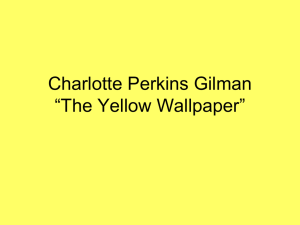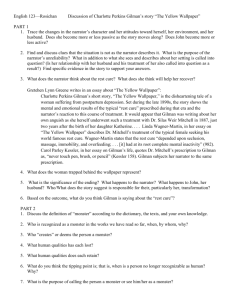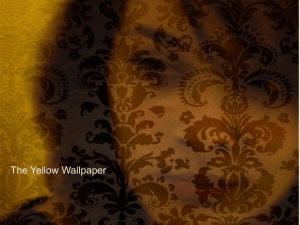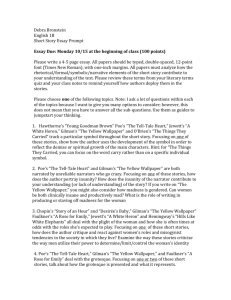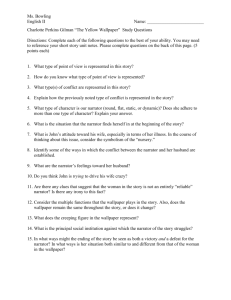While Gilman intended “The Yellow Wallpaper” to be an effort to
advertisement
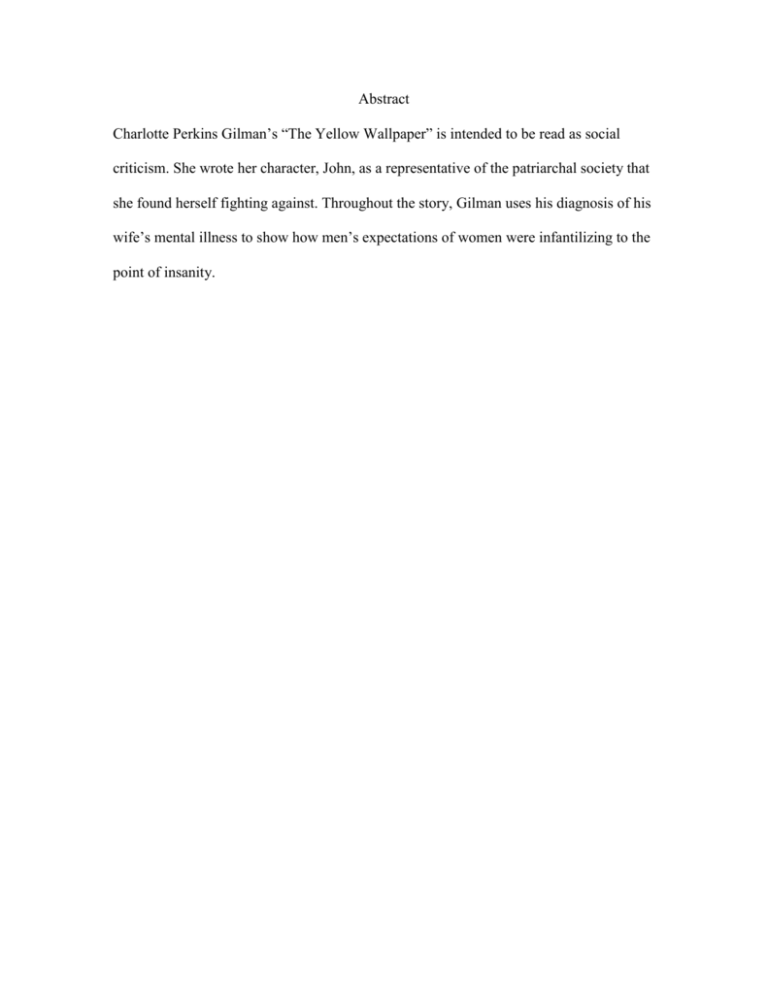
Abstract Charlotte Perkins Gilman’s “The Yellow Wallpaper” is intended to be read as social criticism. She wrote her character, John, as a representative of the patriarchal society that she found herself fighting against. Throughout the story, Gilman uses his diagnosis of his wife’s mental illness to show how men’s expectations of women were infantilizing to the point of insanity. Andrea Shakespeare Dr. Alfred Litton ENG 5263 2 August 2010 From Infancy to Infancy: Gilman’s Portrayal of a “Yellow” Society Charlotte Perkins Gilman’s “The Yellow Wallpaper” has caused much debate in regards to feminism and proper treatment of mental illness. The narrator of the story is suffering from what we now term “postpartum depression” which Gilman herself had struggled with. Scarred by her isolation treatment, Gilman was determined to write this story “with a purpose” (Hochman 90). Throughout the story, the reader learns of the depths of the narrator’s illness, and scholars have questioned whether the cause is internal or external. The ending has also caused much debate about whether the narrator is actually free from her oppression, or further imprisoned in her insanity. While critics say that this piece is disturbing, feminists such as Elaine Hedges claim that this is “one of the rare pieces of literature we have . . . which directly confronts the sexual politics of the male-female, husband-wife relationship” (qtd, in Haney-Pertiz 114). Gilman uses John as a representative of society to create an atmosphere of infancy for the narrator in order to expose how man’s dominance over woman leads to a loss of self ultimately resulting in insanity. Gilman uses John, the narrator’s husband, to demonstrate how women have been “socially, historically, and medically constructed as not only weak, but sick beings” (Suess 80). The story follows the narrator, Jane, who is being isolated and treated for “temporary nervous depression” by her husband, a physician “of high standing” (Gilman). This is the beginning of Gilman’s representation of John as an oppressive husband who treats his wife like a child, in hopes of getting her to act the way he desires. At the beginning the narrator is under the belief that men are smarter and more powerful than women, as seen in the way she responds to John’s medical diagnosis. To this she asks, “What can one do?” and in reference to the medicine he prescribes she says, “phosphates or phosphites-whichever it is” displaying her lack of confidence on the issue of her health (Gilman). Gilman depicts John as a representative of law, order and reality in Jane’s world and describes him as “practical in the extreme” (Gilman). He uses this practicality to scoff “openly at any talk of things not to be felt and seen and put down in figures” (Gilman). Perhaps the most disturbing example of John’s belittling is the former nursery that he put his wife in which seems to infantilize her and remind her of the domestic duties to which she can not attend (Davison 58). The narrator herself seems to unconsciously realize that the room’s restrictions are for “little children” and the “rings and things” are reminiscent of children’s gymnastic equipment (Gilman). Gilman uses these details to portray confinement and imprisonment for this artistic woman. One can see John’s mocking of his wife even in his medical diagnosis. By suffocating the narrator’s imagination with “the patriarchal language of medicine, John . . . speaks to define [every] woman’s condition” (Suess 86). Gilman used his belittling to describe the general treatment of women in that day. She also uses the idea of illness and Jane’s medical care to portray John’s coercion throughout the story. Barbara Suess, in her article “The Writing’s on the Wall: Symbolic Orders in ‘The Yellow Wallpaper,’” quoted Jeannette King and Pam Morris in saying that the narrator seems to accept her mental illness in an attempt to appease John (87). They go on to say that her illness “stems from guilt over her failure to achieve the feminine ideal of caring mother and dutiful wife” (Suess 87). Gilman is strategic in using Jane’s suggestions to John about her health to further demonstrate his reign over her. For example, several times Jane offers suggestions about her treatment which John immediately discredits and “says the very worst thing” that she could do is to dwell on her “condition” (Gilman). Through the interactions between John and his wife, Gilman shows that “a patriarchal culture’s socialization of women makes them ill” (Haney Peritz 122). At the beginning of the story, Jane throws in a sardonic comment about John’s profession being “one reason I do not get well faster” (Gilman). As Suess points out, “any astute reader cannot help but perceive the conscious irony inherent in Jane’s overt pairing of her awareness of John’s counterproductive medical advice with her (supposed) verification of his sagacity and devotion” (87). It seems as though Jane is realizing that John is using her “illness” as a way to guilt her into doing the domestic duties she has not been performing. There is an unspoken dialogue throughout the story between John and his wife about her being both well and ill, which Gilman uses to comment on society’s issue of “man’s prescriptive discourse about a woman” (Haney-Peritz 116). Soon John begins expressing concern over his wife’s writing. For him, her writing is something which he can not control, and therefore he wishes to terminate. He convinces his wife that she should “check the tendency” to write in creative ways, telling her that her “imaginative power and habit of story-making” only intensifies her “nervous weakness” (Gilman). In her article “The Reading Habit and ‘The Yellow Wallpaper’”, Barbara Hochman claims he can continue to “confine her to domestic functions” by dismissing her imaginative ideas (95). However, despite John’s best efforts, his wife continues to write to “relieve the press of ideas” (Gilman). Jane feels the need to express her ideas through writing since John dismisses her ideas in conversation. Gilman uses Jane’s writing as a “doubly told narrative” which aids to the idea of Jane’s true identity within the wallpaper (Johnston 77). She becomes more absorbed in her writing and very possessive of the content, saying “there are things in that paper that nobody knows but me or ever will” (Gilman). Jane has found an identity that she feels reflects her and will now continue in diligently protecting it. In restraining his wife’s capacity to write, John is promoting a “constraining ideology of femininity” which Gilman used to reveal the unreasonable treatment women received (Davison 60). As Jane becomes aware of John’s continuous attempts to manipulate her, the diary-like excerpts provide evidence that she was turning the tables on his authority (Suess 87). She begins describing John in sarcastic and mocking ways, saying “he is so wise” and “he loves me so” (Gilman). However, as her desire to write dwindles and she becomes more curious with the wallpaper, her writing becomes more of a response to the restrictions her husband has inflicted on her; she begins writing only in secrecy. Through Gilman’s use of mockery in the narrator’s counter writing, she has become a conspirator against the patriarchy that is holding her hostage. The use of the wallpaper itself is crucial to Gilman’s intentions in that it adds to Jane’s fascination of its “movement.” Wallpaper is usually considered a feminine decoration, and Gilman has used it here to symbolize female imprisonment. Gilman uses the differentiating patterns in the wallpaper, along with the image of the woman behind bards, to “represent the patriarchal text in which women . . . are trapped” (Hochman 91). The word “pattern” typically describes the model or example of the way something is meant to be, and was used in the nineteenth century “in association with the feminine ideal” (Davison 62). Between the narrator’s descriptions of the different patterns, and her self identification with the woman in the paper, one can grasp the severity of her mental confinement by man (her husband). As Jane describes the pattern of the wallpaper, we see Gilman’s suggestion that the “social ideal of femininity is irrational and may engender insanity (Davison 62). By staying prisoner to the feminine ideal, women may feel trapped and see no escape, leading to eventual insanity. John’s application of control, combined with his admiration of his sister Jennie’s domestic abilities represents the embodiment of the feminine ideal in his mind (Davison 60). In this story, we see Jennie as the personification of the pattern for which John wishes his wife would emulate. Jennie spends time tending to the house and the baby, all things that Jane can not do because of her “illness.” She stands in stark contrast to Jane, being the “domestic ideal,” who is completely content in her position as caretaker (Davison 60). The narrator’s lack of freedom, which Gilman used to reflect the status of American women, can not be more strategically highlighted than when she notes the passing of the Fourth of July. Gilman chose Independence Day to reveal America as “a nation antipathetic to female autonomy” (Davison 67). It is almost as if Gilman uses slight satire to express the passing of Independence Day, suggesting that the celebration of freedom this day represents is no longer available for our narrator. “Well, the Fourth of July is over!” (Gilman) Carol Margaret Davison concluded in her article “Haunted House/Haunted Heroine: Female Gothic Closets in ‘The Yellow Wallpaper’” that Gilman was suggesting that “until men regard women as vocal desiring subjects as opposed to silenced objects of desire, America- and, more specifically, its domestic sphere” will remain an oppressive backdrop for women (67). Upon finally recognizing the image within the wallpaper as a woman behind bars, Jane claims that the pattern “strangles so” inferring the domestic ideals imprison women in their own lives (Gilman). The narrator, and perhaps Gilman, feels imprisoned behind the “bars” of domestic responsibility. In his article, “Escaping the Jaundiced Eye: Foucauldian Panopticism in Charlotte Perkins Gilman’s ‘The Yellow Wallpaper’” John Bak compares the figurative woman’s imprisonment to Jane’s confinement, which helps her to free herself, if only mentally (44). Jane uses the woman in the wallpaper to explain how the woman behind the wallpaper behaves differently during the day, which Gilman uses to represent surveillance, as opposed to in the moonlight when she is free from man’s supervision. She noticed that the paper “changes as the light changes” noting that “when there is a moon- I wouldn’t know it was the same paper” (Gilman). The narrator and the figurative woman exist in two different worlds, “the daylight world of masculine order and domestic routine,” and her “subjective sphere of deepening imaginative insight” (Johnson 523). She admits that her behavior when John is not around “cultivates deceit” because she knows that he would not want to her to be writing or rubbing against the wall (Gilman). Jane believes that the woman in the wallpaper escapes in the daylight, as she has seen her “out of every one of [my] windows” (Gilman). The woman’s actions are important to Jane because they mirror her desires, to be free from the wallpaper “that she believes is monitoring her every move” (Bak 44). In describing the wallpaper the narrator observes, “on a pattern like this, by daylight, there is a lack of sequence, a defiance of law that is a constant irritant to a normal mind” implying that she believes her mind to be sane, and the pattern implemented upon her to be a cause of insanity (Gilman). Near the end of the story, as Jane realizes her identity within the wallpaper, she suggests that John and Jennie are conspiring against her in order to keep her confined. By rejecting her needs and denying her legitimacy, John has caused his wife’s distrust to “blossom into a paranoid conviction that she is the victim of a well orchestrated conspiracy” involving John and Jennie (Davison 60). She believes this so much that she feels “sure John and Jennie are secretly affected by it” (Gilman). They begin to have inconsistencies between their words and actions, which Jane points out. For example, several times she recognizes that John “seems very queer” and that he “pretended to be very loving and kind” which she followed with “as if I couldn’t see through him” (Gilman). After pulling off yards of wallpaper, Jennie looks at it and says “she wouldn’t mind doing it herself” leading the reader to wonder if she too desires to break free of the domestic sphere. John’s character is further enhanced through Gilman’s use of these inconsistencies by connecting him to society, Davison claims that “America seems to be full of Johns” (Davison 48). Gilman puts the idea of “a great many women behind” the wallpaper to symbolize the women in America who were being held back by the masculine ideals of the day (Gilman). She has created a new self identity and “sense of communality through her connection with” the women in the wallpaper (Suess 92). Gilman wanted to portray Jane as realizing her identity outside of the domestic sphere that had been created for her. By connecting with the woman in the wallpaper, Jane has transformed from illness to health, finding a new liberty that she had not known before. Hochman has described Jane’s self recognition within the wallpaper as “a practice that divorces her from reality” which cost a great price, her perceived sanity (98). Gilman is working through Jane to “reinvent . . . a world of her own device” so that she can function outside the walls that have confined her existence (Suess 82). Gilman concludes with Jane prompting the women in America, “I wonder if they all come out of that wallpaper as I did?” (Gilman) The conclusion of this story is one that has left many readers debating Gilman’s intention. On the one hand, the narrator is liberated from the wallpaper and her husband’s controlling prescriptions. However, critics disagree whether Jane- or Gilman- has succeeded in breaking free from the masculine ideal. This strange liberty that Jane has now gained after she “pulled off most of the paper” seems to be at the cost of her sanity (Gilman). She has “freed” the woman in the wallpaper along with herself, however Elaine Hedges argues that she “never does get free” and instead “has been defeated” suggesting that John has reduced her to the state of infancy he has enforced upon her (Bak 40). Georgia Johnson states in her article “Exploring Lack and Absence in the Body/Text: Charlotte Perkins Gilman Prewriting Irigaray” that she believes that rather than insanity at the story’s close, Jane is displaying a “long suppressed rage” at being kept in captivity for so long (522). Although Jane seems to be insane at the story’s conclusion, she is, for the first time, free of the identity that the John’s patriarchal society had given her. Davison claims that Jane has never been as sane than when she appears the most insane (67). The narrator’s complex descriptions of the horrors of living under John’s oppression are demonstrated in the final scene with the “senseless and crawling, infantile” Jane in a position of submission (Davison 66). At the end of the story, Jane seems to “cry at nothing, and cry most of the time” leading the reader to see the connection between her actions and an infant’s (Gilman). Jane’s descent into infancy began when she could not even choose which room to live in; “John would not hear of it” (Gilman). Gilman also uses John’s words to further infantilize Jane, calling her “little girl” and saying “bless her little heart” (Gilman). At one point, after she breaks down crying in front of John, he “gathered” her up in his arms, “just carried” her up the stairs and “laid” her on the bed to read to her until it “tired” her head. Gilman displays an image of a father gathering up his child and soothing them into sleep. She uses John’s dominance over Jane to portray society’s masculine ideal that forced women to succumb to their husband’s will. Gilman’s “The Yellow Wallpaper” directly confronts society’s issue of male dominance to the point of bringing a woman to a state of infancy in the home. Hochman adds to the claim that Gilman intended for this story to be read as social criticism (99). In the end, Jane is “stripped entirely of her sanity and humanity and left crawling on all fours in . . . smooches” as an infant in her nursery (Bak 39). John has lead Jane into her insanity through his use of mockery and belittling. Gilman also used his position as a physician to control Jane’s daily activities, giving her a “schedule prescription for each hour in the day” (Gilman). Through Gilman’s mentioning of Independence Day, she paints a picture of imprisonment in the room where the “windows are barred” (Gilman). The story’s imagery shows readers that Gilman wanted to encourage other women to break free. However, she leaves the question of whether or not it is possible in a patriarchal society. As Jane and the woman in the wallpaper “take hold of the bars,” Gilman portrays the psychological toll that causes a different type of imprisonment (Gilman). This reveals a dilemma women are forced to face in society: follow the pattern or rip the wallpaper from the walls. Works Cited Bak, John S. "Escaping the Jaundiced Eye: Foucauldian Panopticism in Charlotte Perkins Gilman's `The Yellow.." Studies in Short Fiction 31.1 (1994): 39. Web. Davison, Carol Margaret. "Haunted House/Haunted Heroine: Female Gothic Closets in "the Yellow Wallpaper"." Women's Studies 33.1 (2004): 47-75. Web. Haney-Peritz, Janice. "Monumental Feminism and Literature's Ancestral House: Another Look at 'the Yellow Wallpaper'." Women's Studies 12.2 (1986): 113. Web. Hochman, Barbara. "The Reading Habit and 'the Yellow Wallpaper.'." American Literature 74.1 (2002): 89. Web. Johnson, Greg. "Gilman's Gothic Allegory: Rage and Redemption in "the Yellow Wallpaper"." Studies in Short Fiction 26.4 (1989): 521-30. Web. Johnston, G. "Exploring Lack and Absence in the body/text: Charlotte Perkins Gilman Prewriting Irigaray." Women's Studies 21.1 (1992): 75. Web. Perkins Gilman, Charlotte. "The Yellow Wallpaper." Literary Cavalcade 53.8 (2001): 14. Web. Suess, Barbara A. "The Writing's on the Wall" Symbolic Orders in 'the Yellow Wallpaper'." Women's Studies 32.1 (2003): 79. Web. Perspective of Foucauldian Panopticism." US-China Foreign Language 5.3 (2007): 52-7. Web.
